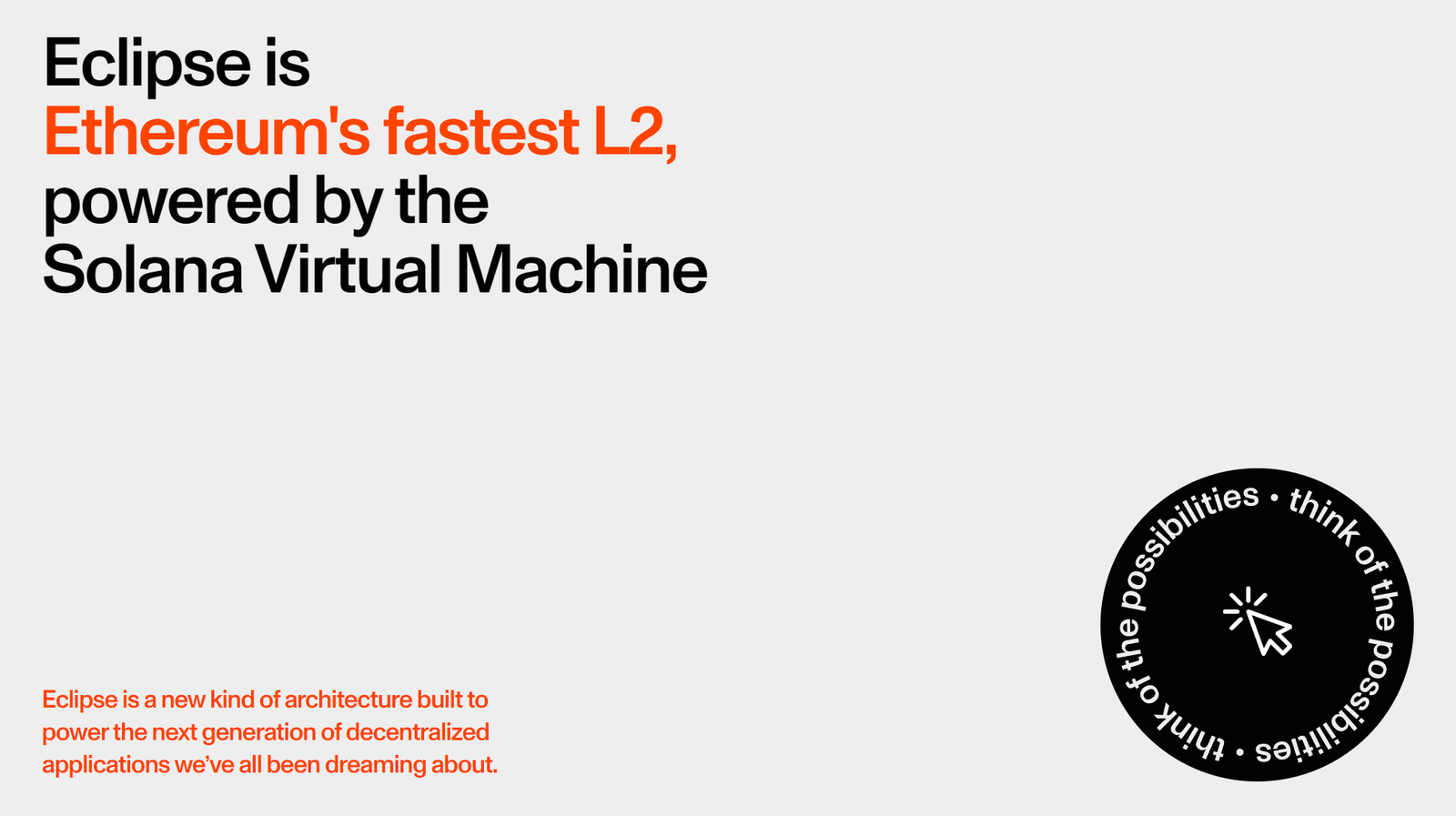Demystifying Eclipse: Unveiling the Power of Layer 2
Dive into the realm of Eclipse, a trailblazing Layer 2 solution revolutionizing Ethereum with the prowess of the Solana Virtual Machine. Explore its feature set and glimpse into its promising future.
In Brief:
Eclipse stands at the vanguard of Layer 2 solutions for Ethereum, propelling transaction processing to new heights by harnessing the Solana Virtual Machine (SVM). Engineered for speed and scalability, Eclipse embraces a modular rollup framework, seamlessly melding pivotal technologies like Ethereum for settlements, SVM for smart contracts, Celestia for data accessibility, and RISC Zero for impregnable security. Despite robust venture capital backing, the platform opts out of the governance token route. Spearheaded by Neel Somani, a luminary with a diverse tech and finance background, Eclipse seeks to redefine the benchmarks of blockchain scalability and performance.

Understanding Eclipse:
Eclipse emerges as a cutting-edge Layer 2 panacea for the Ethereum blockchain, promising an epochal surge in transaction processing speed through the astute application of the Solana Virtual Machine (SVM). Unlike its monolithic counterparts, Eclipse embraces a modular rollup architecture, affording developers the liberty to tailor their blockchain’s functionality and efficiency to their precise needs.
At present, Eclipse offers support for both Ethereum and Solana Virtual Machines, presenting developers with a menu of options spanning virtual machine performance, security fortifications, and data accessibility strata. With its implementation of the Ethereum Virtual Machine (EVM), Eclipse flaunts a processing velocity tenfold superior to contenders like Optimism.

How does Eclipse Work?
Eclipse Mainnet functions as Ethereum’s swift and scalable decentralized applications (dApps) haven, operating as a Layer 2 solution. Here’s a detailed probe into its technological arsenal:
- The Pillar of Settlement – Ethereum: Eclipse adopts Ethereum as its bedrock settlement layer, ensuring that transactions find their finality and security on the Ethereum blockchain. ETH dons the mantle of the transaction fee gas token, endowing Eclipse with the robust security and liquidity inherent to Ethereum.
- The Nexus of Execution – Solana Virtual Machine (SVM): For the execution of application logic and smart contracts, Eclipse enlists the prowess of Solana’s Virtual Machine (SVM). A standout feature lies in its ability to process transactions in parallel through the Sealevel runtime, a sharp departure from Ethereum’s Virtual Machine (EVM), which adheres to a sequential transaction execution model. This horizontal scalability empowers Eclipse to leverage multi-core processors, amping up throughput.
- Data in the Limelight – Celestia: Eclipse entrusts Celestia with the pivotal role of ensuring data availability and verifiability. This furnishes a secure and scalable platform for data dissemination, constituting a cornerstone for Eclipse’s impressive throughput.
- Sentinel of Integrity – RISC Zero: For validation and zero-knowledge proofs, Eclipse incorporates the formidable RISC Zero, eliminating the need for intermediate-state serialization and bolstering the system’s efficiency and security.
The interplay of these components bequeaths Eclipse Mainnet with an environment that is both scalable and secure, fostering efficiency in dApp operations. With the Solana Virtual Machine at its core, Eclipse engineers parallel transaction processing, culminating in elevated throughput. It embraces local fee markets, circumventing the pitfalls of state growth, two inherent challenges facing Ethereum’s EVM.

The Enigma of Solana Virtual Machine (SVM):
The Solana Virtual Machine (SVM) serves as the computational workhorse propelling the Solana blockchain. Engineered for high-speed transaction processing and execution of smart contracts, it earns its stripes as one of the fleetest blockchain platforms in existence. Within the context of Eclipse, the SVM assumes a pivotal role as the host for Eclipse’s Layer 2 infrastructure. This synergy empowers Eclipse to offer nimble transaction processing, reaping the benefits of Solana’s exceptional throughput and minimal latency. By harmonizing with both Ethereum and Solana Virtual Machines, Eclipse extends a pliable and efficient canvas for developers and users alike.
Will Eclipse Have a Token?
Despite securing a princely sum of $15 million from venerable venture capital firms like Polychain Capital, Polygon Ventures, and Tribe Capital, Eclipse has unequivocally stated that there are no immediate plans to unfurl a governance token. This confirmation stems from a direct exchange with the Eclipse team on Twitter. While the substantial financial backing might hint at the potential for a token in the offing, the team has made it abundantly clear that it does not align with their current roadmap.
Meet the Minds behind Eclipse:
Neel Somani emerges as the visionary architect of Eclipse, a venture laser-focused on birthing a “universal Layer-2” solution capable of scaling multiple Layer-1 blockchains. Nestled in the vibrant environs of the San Francisco Bay Area, Neel brings to bear a tapestry of erudition spanning computer science, mathematics, and business administration from the hallowed halls of the University of California, Berkeley.
Before unfurling the banner of Eclipse, Neel honed his acumen in revered bastions of knowledge. He donned the mantle of Quantitative Research Analyst at Citadel and lent his expertise as a Software Engineer at Airbnb. These diverse odysseys render him uniquely poised to helm a project straddling the realms of technology and finance.
In Summation:
Eclipse’s audacious architectural design emerges as the harbinger of a new era in blockchain scalability and performance. By embracing a modular rollup paradigm and seamlessly integrating Ethereum for settlements, Solana Virtual Machine for smart contracts, Celestia for data accessibility, and RISC Zero for impregnable security, Eclipse forges an ecosystem that marries high throughput, ironclad security, and operational efficiency. This positions it as an alluring choice for developers poised to construct dApps that scale and perform admirably on the Ethereum blockchain.



